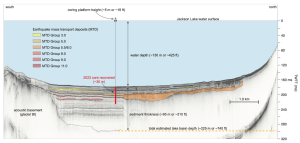Hunting Teton paleo-earthquake records in the deep parts of Jackson Lake
Presentation: “Hunting Teton paleo-earthquake records in the deep parts of Jackson Lake” by Dr. Ryan Thigpen, University of Kentucky
March 5th (Tuesday), 6 p.m., Social half-hour; please join us from 5:30-6:00 to enjoy free soft drinks and appetizers before our talk begins!
Live at the Teton County Library & Via Zoom (online)
Reconstructing the timing, magnitude, and recurrence interval of Teton fault earthquakes for the last 15,000 years is a persistent and enigmatic challenge for the geology and hazards communities. Trenches across the active fault have clearly established at least two, and potentially three, major events in the last ~10,000 years. However, recent studies of sediments in moraine lakes adjacent to the fault highlighted more potential events that were not observed in the fault trenches. Although lake sediments can be more sensitive paleo-earthquake “recorders” than their trench counterparts, these turbidites and Mass Transport Deposits (MTDs) in lakes can have a range of non-seismic drivers. Additionally, collecting geophysical surveys and cores in these deep-water lake settings poses significant logistical and scientific challenges.
In this talk, we will discuss the preliminary results of a multiyear seismic reflection survey that culminated in the collection of a ~31 m (~100 ft) continuous long core from a water depth of ~425 ft in Jackson Lake in September 2023. An ash layer near the bottom of the core indicates a match with the ~11.2 ka Glacier Peak eruption, constraining the maximum core age. In the core, at least 8 MTD intervals (and many paleo-wildfires) have been identified. Lake-wide seismic mapping has demonstrated that each of these core-derived MTD events corresponds to discrete and instantaneous intervals that include multiple MTD deposits lake wide. This phenomenon, wherein triggering of multiple underwater landslides, turbidites, and MTDs occurs during a single instantaneous interval, is known as the “synchronicity criterion” and allows us to interpret these core MTDs as being “seismites” derived from earthquake activity. Ongoing radiocarbon geochronology will allow us to assign precise ages to these seismic events, which should provide significant new learnings about the history of Teton fault earthquakes over the past ~11,000 years.
Coring Operations, Jackson Lake
Seismic line across Jackson Lake showing core location.
Topic: Hunting Teton paleo-earthquake records in the deep parts of Jackson Lake
Time: Tuesday March 5th, 2024 06:00 PM Mountain Time (US and Canada)
Join Zoom Meeting
https://us02web.zoom.us/j/4555651818?pwd=U09ObDNZOEIyZmRtMEtsdUowQnJqdz09
Meeting ID: 455 565 1818
Passcode: 576063


